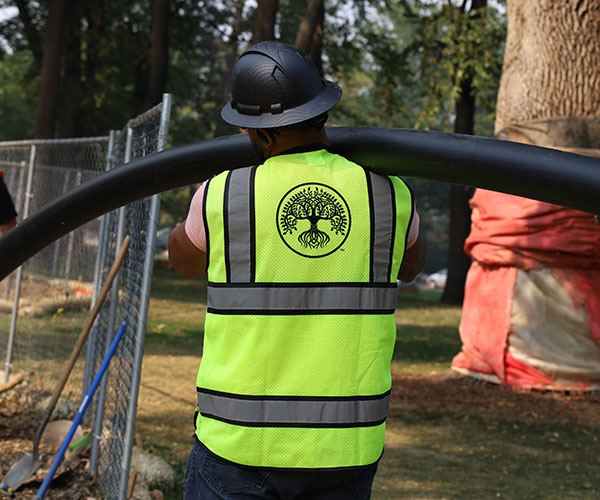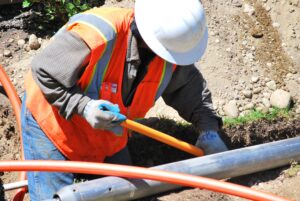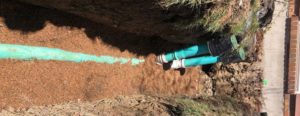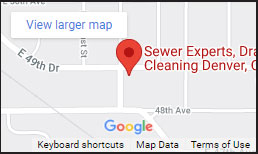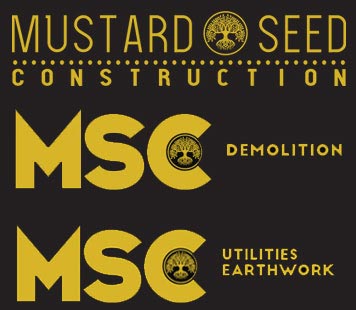Introduction
So, what is a sewer line exactly? A sewer line is a pipe that moves waste water from your home to the city sewer system. This main sewer line runs under your yard. It connects all your drains to the public sewer. When you flush a toilet or drain a sink, waste flows through your home’s sewer line system. But most people never think about their sewer line until problems happen. Then, sewer line issues can cause big headaches and cost a lot to fix.
Your main sewer line does important work every single day. It carries all the waste water away from your house. Without a working sewer line, your home would face serious health risks. Plus, sewer line damage can flood your yard with raw sewage. That’s why knowing how sewer systems work helps you catch problems early.
This guide explains what a sewer line does in simple terms. You’ll learn how main sewer lines work. We’ll cover common sewer line problems too. After that, you’ll know when to call Denver sewer repair experts. Most importantly, you’ll understand why sewer line maintenance matters for your home.
Table of Contents
- What Is a Sewer Line and Its Main Purpose
- How Main Sewer Lines Work in Your Home
- What Does a Sewer Line Do Every Day
- Common Sewer Line Problems Denver Homeowners Face
- How Sewer Systems Work From House to City
What Is a Sewer Line and Its Main Purpose
A sewer line is a pipe that carries waste water away from your home. This main sewer line connects your house drains to the city sewer system. So, every drain in your home feeds into this one main pipe. The sewer line runs underground from your house to the street. Then it connects to the municipal sewer system.
Most sewer lines are made from clay, cast iron, or PVC pipe. Older homes often have clay or cast iron sewer lines. These materials can crack or break down over time. Newer homes use PVC because it lasts longer. But all sewer lines need proper care to work right.
Why Your Main Sewer Line Matters
Your main sewer line handles all the waste water from your home. It carries water from toilets, sinks, showers, and washing machines. Without a working sewer line, waste water has nowhere to go. That means sewage backs up into your house. Plus, broken sewer lines can contaminate your yard and drinking water.
The sewer line slope matters a lot for proper flow. Pipes must slope down at the right angle. This helps gravity move waste water toward the city sewer. If the slope is wrong, waste can get stuck in your sewer line.
Key Takeaway: Your main sewer line is the most important drain pipe in your home because it handles all waste water removal.
How Main Sewer Lines Work in Your Home
Main sewer lines work using gravity to move waste water. When you flush or drain water, it flows down through your home’s drain pipes. All these pipes connect to one main sewer line. Then gravity pulls the waste water down and out to the street.
The typical residential sewer system has several key parts. First, drain pipes inside your home carry waste to the main stack. This vertical pipe runs through your house. Next, the main stack connects to your lateral sewer line. This horizontal pipe runs under your yard to the city sewer main in the street.
Understanding Sewer System Components
Your home sewer system has three main parts. The drain pipes inside your house are the first part. These connect to sinks, toilets, and other fixtures. Second, the main stack is a large vertical pipe. It connects all your drains together. Third, the lateral sewer line runs from your house to the street.
Vent pipes are also crucial for how sewer systems work. These pipes let air into your drain system. Air helps water flow smoothly through sewer lines. Without proper venting, your drains would gurgle and drain slowly.
Tree roots are a common threat to main sewer lines. Roots grow toward water sources like sewer pipes. They can crack pipes and grow inside them. Then waste water can’t flow properly through your sewer line.
Expert Insight from Marisa Beaver, Denver Sewer Repair Specialist: Most Denver homeowners don’t know their sewer line exists until something goes wrong. But regular sewer line inspections catch problems early. This saves you thousands in emergency repairs. Plus, modern camera technology lets us see inside your sewer line without digging.
What Does a Sewer Line Do Every Day
A sewer line does one main job: it moves waste water away from your home. Every time you use water, that water must go somewhere. So, your sewer line carries it to the city treatment plant. This happens 24 hours a day, seven days a week.
Your main sewer line handles enormous amounts of water. An average family uses 300 gallons of water per day. All that water flows through your sewer line. The pipe must stay clear and undamaged to handle this flow.
Daily Sewer Line Functions
The sewer line transports more than just toilet waste. It also carries water from showers, washing machines, and dishwashers. Kitchen sink waste with food particles flows through it too. Even the water from your bathroom sink goes through your main sewer line.
Grease is a major enemy of sewer lines. When grease cools in pipes, it hardens. Then it blocks water flow through your sewer line. Over time, grease buildup causes complete sewer line blockages. That’s why you should never pour grease down any drain.
Hair and soap scum also affect sewer line function. These materials stick to pipe walls. They slowly reduce the pipe’s diameter. Eventually, your sewer line can’t carry enough water. Then you get slow drains or backups.
Pro Tip: Pour hot water down your drains weekly to help prevent grease buildup in your sewer line.
Our Denver drain cleaning services remove clogs before they become major sewer line problems.
Common Sewer Line Problems Denver Homeowners Face
Denver homeowners face several common sewer line issues. Tree roots cause many sewer line problems in older neighborhoods. Clay pipes are especially vulnerable to root intrusion. Once roots get inside, they grow quickly and block the entire sewer line.
Freezing temperatures can also damage sewer lines in Colorado. When water freezes inside pipes, it expands. This pressure can crack your main sewer line. Deep frost penetration during harsh winters makes this problem worse.
Signs Your Sewer Line Needs Repair
Multiple slow drains indicate a main sewer line problem. If one drain is slow, it’s usually a local clog. But when all your drains are slow, your sewer line likely has a blockage. This is a serious warning sign.
Bad smells coming from drains mean your sewer line isn’t working right. Sewer gas should exit through vent pipes on your roof. If you smell sewage inside, your sewer line might be cracked or blocked.
Sewage backups are the most obvious sewer line problem. Water or waste coming up through drains needs immediate attention. This means your main sewer line is completely blocked or damaged. You need emergency sewer line repair right away.
Wet spots in your yard can signal a broken sewer line. When pipes crack, water leaks into the surrounding soil. You might see grass that’s extra green or soggy areas. These spots often smell bad too.
Common Mistake to Avoid: Many people use chemical drain cleaners for sewer line clogs. But harsh chemicals can damage old pipes and make problems worse.
How Sewer Systems Work From House to City
Understanding how sewer systems work helps you maintain your home. Your lateral sewer line starts at your house foundation. It slopes downward as it crosses your property. At the property line, it connects to the city’s main sewer line.
The municipal wastewater system then carries waste to treatment plants. Treatment removes harmful bacteria and pollutants. Clean water returns to rivers and streams. This process protects public health and the environment.
The Journey of Waste Water
Waste water begins its journey when you use any drain. It flows through your home’s drain pipes first. All these pipes feed into your main sewer line. Gravity pulls the water down and out of your house.
Your lateral sewer line slopes about 1/4 inch per foot. This grade ensures proper flow without being too steep. If the sewer line slope is wrong, waste can’t move properly. Then you get clogs and backups.
City sewer mains are much larger than home sewer lines. They’re built to handle waste from many houses. Pump stations help move sewage when gravity isn’t enough. Eventually, all waste reaches the treatment plant.
Modern sewer line technology has improved waste water management. CIPP lining can repair damaged sewer lines without digging. This trenchless method saves your landscaping. Plus, the new liner lasts 50 years or more.
What Happens at the Treatment Plant
Treatment plants remove solids from sewage first. Then bacteria break down organic waste. Chemical treatments kill harmful germs. Finally, clean water is released safely back into nature.
The treatment process protects your community’s health. It prevents disease from contaminated water. Well-maintained sewer systems make this possible. That’s why your main sewer line matters beyond just your home.
Our trenchless sewer repair services use modern CIPP lining technology to fix sewer lines with minimal yard damage.
Conclusion and Next Steps
Now you know what a sewer line is and how it works. Your main sewer line carries all waste water from your home to the city system. It works using gravity and proper pipe slope. When your sewer line fails, you face sewage backups and health hazards. But regular maintenance prevents most sewer line problems.
Watch for warning signs like slow drains and bad smells. These indicate your sewer line needs attention. Don’t wait for a complete backup to call for help. Early sewer line inspection saves money and stress.
Denver homeowners should have their main sewer line inspected every few years. Older homes with clay or cast iron pipes need more frequent checks. Tree roots and freezing damage are common in Colorado. Professional sewer camera inspection shows exactly what’s happening inside your pipes.
Get Expert Sewer Line Help in Denver
Sewerex has served Denver homeowners for over 20 years. Our team specializes in sewer line repair and replacement. We use modern trenchless technology to fix sewer lines fast. This means less digging and lower costs for you.
Schedule your sewer line inspection today. We’ll check your main sewer line with advanced camera equipment. Then we’ll explain exactly what repairs you need. Our honest pricing and quality work have made us Denver’s trusted sewer experts.
Don’t let sewer line problems damage your home. Call Sewerex at the first sign of trouble. We’re available 24/7 for emergency sewer repairs. Plus, our trenchless methods protect your yard and landscaping.
Frequently Asked Questions
What is a sewer line and where is it located?
A sewer line is a pipe that moves waste water from your home. It runs underground from your house to the street. Then it connects to the city’s main sewer system. Most sewer lines are 4 to 6 inches in diameter. They’re buried 2 to 6 feet deep in your yard.
How do main sewer lines differ from drain pipes?
Main sewer lines carry waste from all your drains to the city sewer. Drain pipes inside your home connect to the main sewer line. So, drain pipes are smaller and only serve individual fixtures. The main sewer line handles your entire home’s waste water.
How often should I inspect my sewer line?
You should inspect your sewer line every 2 to 3 years. Older homes need annual sewer line inspections. Also, inspect after buying a home or before major landscaping. Camera inspections show problems before they become emergencies.
What causes sewer line clogs and backups?
Tree roots cause most sewer line blockages in Denver. Grease buildup and foreign objects also clog sewer lines. Old pipes can collapse and block water flow too. Plus, improper pipe slope leads to waste accumulation.
When should I call a professional for sewer line repair?
Call professionals immediately if you have sewage backups or multiple slow drains. Bad smells from drains also need expert attention. Wet spots in your yard mean your sewer line might be broken. Don’t try to fix main sewer line problems yourself.
Step-by-Step: How to Identify Sewer Line Problems
How to Check Your Sewer Line for Issues:
- Run water in all your sinks and watch how fast it drains.
- Flush every toilet and listen for gurgling sounds from other drains.
- Check your basement floor drains for standing water or backup.
- Walk your yard and look for soggy spots or extra green grass.
- Smell near floor drains for sewer gas odors inside your home.
- Run your washing machine and watch other drains for slow flow.
- Note any drains that bubble when you use other fixtures nearby.
- Check your water bill for unexplained increases that suggest leaks.
- Look for cracks in your foundation that might indicate settling from leaks.
- Schedule a professional camera inspection if you notice any warning signs.
Quick Reference: What Is a Sewer Line?
A sewer line is the main pipe that carries all waste water from your home to the city sewer system. It connects every drain, toilet, and fixture in your house. The sewer line uses gravity to move waste water underground from your foundation to the street. Most sewer lines are 4 to 6 inches wide and made from clay, cast iron, or PVC. This crucial pipe handles hundreds of gallons of water daily. When it fails, sewage can back up into your home or leak into your yard.

